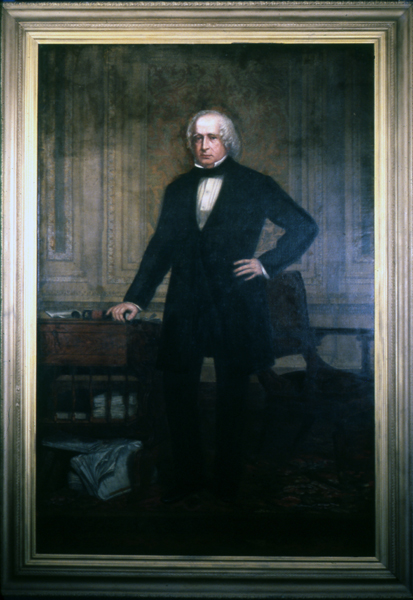Slidell
Surveyed and platted in 1883 for the New Orleans and Northeastern Railroad, Slidell was named for John Slidell, Confederate ambassador to France and U.S. congressman.

Louisiana State Museum
Color reproduction of a formal portrait of John Slidell by Perry Enoch Wood (1831-1915), c. 1860.
Surveyed and platted in 1883 for the New Orleans and Northeastern Railroad, Slidell was named for John Slidell (1793–1871), Confederate ambassador to France and US congressman. His son-in-law was a principal investor in the railroad. The town of Slidell began to grow after Swiss immigrant Fritz Salmen established a brickworks there in 1886. With his brothers, Jacob and Albert, Salmen formed the Salmen Brick and Lumber Company, which operated until the 1920s. Among Slidell’s historic buildings are the railroad depot (1913; 1809 Front Street), a long brick structure covered by a hipped roof, with eaves carried on large decorative brackets; and the Arcade Theater (1927; 2247–2251 Carey Street), a stucco-covered brick structure with a pantile roof that gives a light Mediterranean touch, both located in the city’s Olde Towne District.
Linked to eastern New Orleans by five-mile bridges across the eastern edge of Lake Pontchartrain and located just west of the Stennis Space Center in Hancock County, Mississippi, Slidell blossomed in the 1960s and 1970s as the first true suburb in St. Tammany Parish, then developing as a bedroom community for space-industry workers and others.
Salmen built the one and-one-half-story Salmen-Fritchie House (127 Cleveland Avenue) with a central-hall plan across the street from his brickyard, and he is said to have observed activities at the yard from the parlor’s bay window. Combining Queen Anne and Colonial Revival elements, the house features a deep gallery with paneled piers raised on brick pedestals and a hipped roof with prominent shed dormers decorated with shingles. By 1906 a kitchen ell was added to the rear, and in a further expansion in 1917 the east gallery was transformed into a sun room and a porte-cochere added to it. After Salmen died in 1934, his home was purchased by Homer G. Fritchie, Sr., a relative by marriage and mayor of Slidell from 1930 to 1962. The house now accommodates a catering business and reception center. Another house belonging to the Salmen family (2854 Front Street), perhaps begun by Fritz’s wife, Rosa, who died in 1897, is a Swiss chalet with broad overhanging eaves and elaborate woodwork.
Adapted from Karen Kingsley’s Buildings of Louisiana, part of the Buildings of the United States series commissioned by the Society of Architectural Historians (www.sah.org) and published by Oxford University Press.
